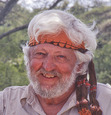Boyd Norton's Blog, page 3
January 28, 2014
Tribute to a Great Person - Pete Seeger
In 1972 I was privileged to take Pete on a whitewater raft trip for several days on the Snake River in Hells Canyon on the Idaho/Oregon border. We were still fighting to preserve the canyon and river from a major dam proposal. Pete was supporting us and, while there, wrote a song about Hells Canyon. I'm saddened by his death. He was one of the great humanitarians of this century and last. And a great conservationist as well. Rest well, Pete.
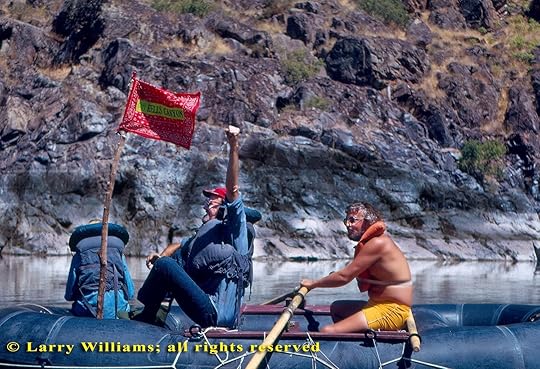 Pete 'n me in a calm section of the Snake River
Pete 'n me in a calm section of the Snake River
 Serenading the Snake River
Serenading the Snake River
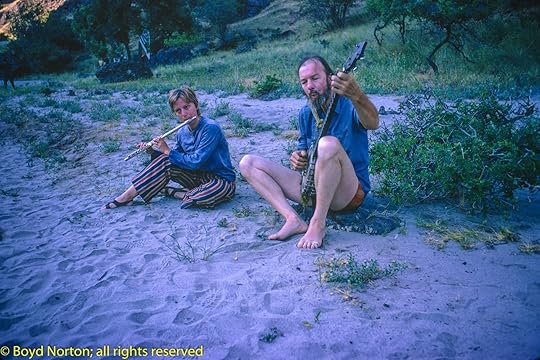 A duet.
A duet.
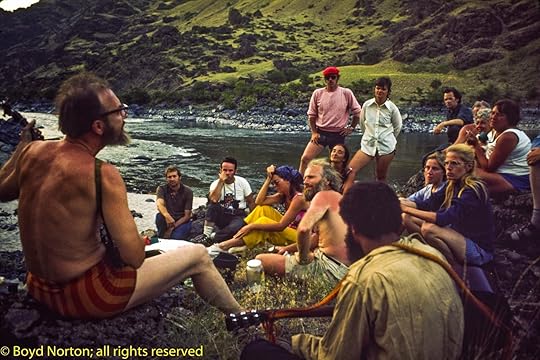 Evening songs for our gang.
Evening songs for our gang.
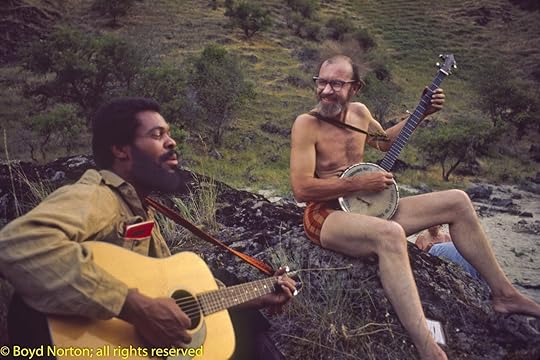 With Jimmy Collier
With Jimmy Collier
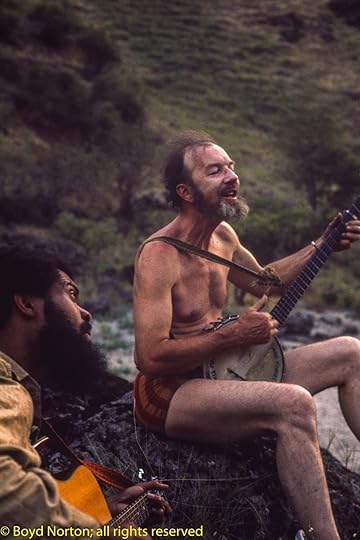 With Jimmy Collier
With Jimmy Collier
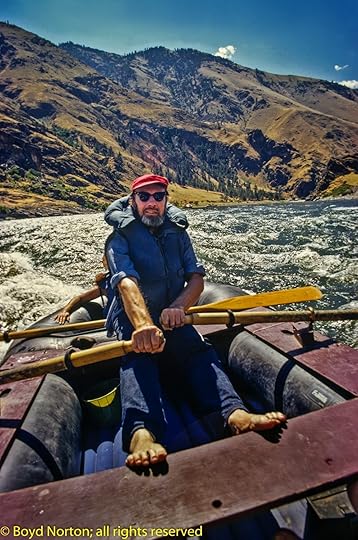 Pete at the oars in white water.
Pete at the oars in white water.
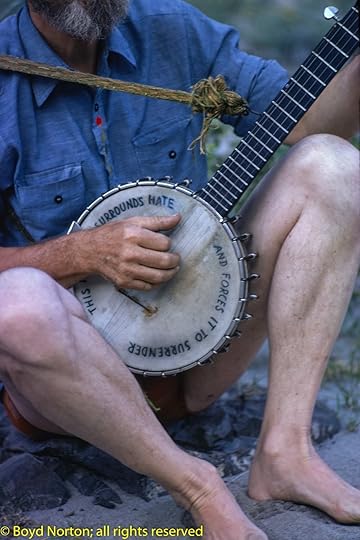 The lettering on Pete's banjo read: This Machine Surrounds Hate and Forces it to Surrender."
The lettering on Pete's banjo read: This Machine Surrounds Hate and Forces it to Surrender."
 Pete 'n me in a calm section of the Snake River
Pete 'n me in a calm section of the Snake River Serenading the Snake River
Serenading the Snake River A duet.
A duet. Evening songs for our gang.
Evening songs for our gang. With Jimmy Collier
With Jimmy Collier  With Jimmy Collier
With Jimmy Collier  Pete at the oars in white water.
Pete at the oars in white water. The lettering on Pete's banjo read: This Machine Surrounds Hate and Forces it to Surrender."
The lettering on Pete's banjo read: This Machine Surrounds Hate and Forces it to Surrender."
Published on January 28, 2014 09:26
November 16, 2013
10th World Wilderness Congress in Spain
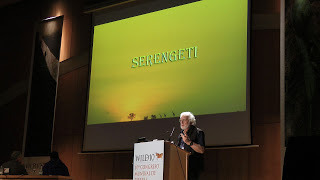 The 10th World Wilderness Congress was held in Salamanca, Spain October 4-10. Attended by about 1000 activists from 60 different countries, it was a pretty high energy gathering. I gave a presentation on our battle to save Serengeti.
The 10th World Wilderness Congress was held in Salamanca, Spain October 4-10. Attended by about 1000 activists from 60 different countries, it was a pretty high energy gathering. I gave a presentation on our battle to save Serengeti.Great networking and contacts. It is always encouraging to see some of the great conservation work being done by others.
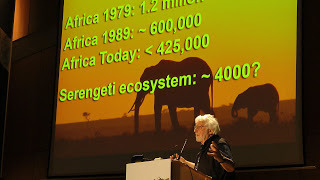 Salamanca is a beautiful city, rich in history. The university here was chartered in 1208. In 1492 old Chris Columbus lobbied the scholars here to convince the king and queen of Spain to fund his crazy scheme to sail across the ocean. We all know what happened after that.
Salamanca is a beautiful city, rich in history. The university here was chartered in 1208. In 1492 old Chris Columbus lobbied the scholars here to convince the king and queen of Spain to fund his crazy scheme to sail across the ocean. We all know what happened after that.
Published on November 16, 2013 09:07
August 19, 2013
December 26, 2012
Travels in Siberia - The Ministry of A&I
© Boyd Norton
Travels in Siberia
The Ministry of A & I From my first visit in 1986, and through many subsequent trips in the 1990s, I became acutely aware that this vast country, under the Soviet system, was run by a labyrinth of ministries in Moscow. No matter where you lived, all these ministries controlled commerce and lives completely. There were some 37 of them, ranging from the Ministry of Agriculture and Food, the Ministry of Coal Industry, the Ministry of Culture to the Ministry of Fisheries, the Ministry of Foreign Affairs and more. There were ministries for Defense, Defense Industry, Geology, Information and Press, Shipbuilding, Oil and Gas, Metallurgy - well, it was an impressive list. And then, of course, there were agencies under these ministries, called Committees, the most noted of which was the Committee for State Security, Комитет государственной безопасности, better known by its Russian initials, KGB. I discovered in my travels that the most important and powerful of all these ministries was a well kept state secret for decades. It was called the Ministry of Aggravation and Irritation. Even today few people know that this agency held sway over every other ministry. Nothing could be built and no policy implemented until the Ministry of A&I had applied its rules. Here are some examples of the secret influence of the Ministry of A&I: Until the late 1990s, all Aeroflot planes were required to have carpeting that was notanchored firmly to the planes’ floors. The result? When stewardesses rolled the food service carts down the aisle, the carpeting would bunch up in front of the wheels. The resulting bumpiness caused food trays to bounce off the carts and into passengers’ laps or on the floor. Considering the quality of the food served, this actually wasn’t as bad as it sounds. It was decreed that no doorway entrance to any hotel or public building be larger than three feet wide. This made it impossible to enter a hotel while carrying a suitcase in each hand. (In fact, you could not enter even carrying one suitcase.) You had to stop, put the suitcases down, push one then the other through the doorway - and hope that no one was trying to exit at the same time. Regarding that last, it was also decreed that all entrances would be exits as well and that there was to be only one entrance/exit per building. On entering or leaving a hotel at busy times of day, you gained enormous respect for those NFL running backs who attempt to blast through a wall of massive defensive linemen. No restroom in any public building was allowed to have toilet seats. You either had to bring your own or do without or wait (if possible). And it was definitely forbidden to have any toilet paper in these public restrooms. For an extensive stay in the Soviet Union you had to bring one suitcase loaded with nothing but toilet paper. The shortage of bum wad all across the country was so great that you could often use a roll or two of TP as a bribe for certain services or goods. As a gift, a roll of toilet paper was on a par with a pack of Marlboros. All hotel elevators were required to hold no more than three small people - and with no luggage. If you had luggage, it was impossible to fit in with your bags. You then had to wait for an empty elevator, load the bags in it, push the floor button, escape before the doors closed, and then race up the stairs to your floor in order to rescue your bags when, and if, the elevator arrived. If your room happened to be on the 5th floor or above, you would be a prime candidate for cardio-pulmonary resuscitation. If the elevator made a stop at some intermediate floor, your suitcases might be off loaded so that someone could enter. This, then, necessitated a floor by floor search for your bags. Checking into a hotel and getting to your room sometimes took the better part of a day. It would not have been so bad, but after the ordeal you needed a drink badly and the bar was always on the first floor. You had to use the stairs because the elevator was loaded with someone’s luggage. There were numerous other things that were a tribute to the success of this ministry in inflicting aggravation and irritation. For example, it was absolutely forbidden to have smooth sidewalks, especially those in the vicinity of airports, train stations or hotels. If you had a suitcase with roller wheels the irregular surface of the sidewalks made it impossible to tow it very far without it falling over. It wasn’t until the late 1990s that the Ministry of A&I began to lose its influence. Before that all Aeroflot planes had to have open overhead bins (the ministry did not allow overheads with closed and latched doors). Any turbulence during a flight resulted in some interesting items bouncing out of the overheads and landing in your lap or on your head - chickens, paper bags full of eggs, someone’s dirty laundry, a birthday cake, and - no lie, it actually happened to me - a box of live crayfish. In full disclosure, the owner of that box, perhaps fearful that it would fall, had taken it out of the overhead bin and set it in the aisle next to his seat. The vibration of the plane panicked the crayfish and, before the owner noticed it, a number of them escaped and dispersed under the seats - causing a mild panic among the passengers before most were rescued and returned to the box. I never learned why he had a box of live crayfish - perhaps some Siberian Étouffée recipe? Today in Russia the equivalent of our TSA now has crayfish detectors at each airport. Finally, the Ministry of A&I came up with a brilliant scheme to announce its existence and importance to anyone arriving in the Soviet Union: speed bumps the full length of all airport runways. On an Alaska Airlines flight in the early 1990s, we touched down on the brand new runway at Magadan and immediately the plane bounced and rattled so violently that passengers appeared to be on an amusement park ride. Heads bobbed up and down, eyes bulged wide with panic and knuckles whitened. The shaking and rattling continued until the plane had slowed considerably, at which time the pilot came on and, in a vibrating voice rich in sarcasm, said “Welcome to Russia.” The Ministry of A&I had notched yet another grand achievement.
Travels in Siberia
The Ministry of A & I From my first visit in 1986, and through many subsequent trips in the 1990s, I became acutely aware that this vast country, under the Soviet system, was run by a labyrinth of ministries in Moscow. No matter where you lived, all these ministries controlled commerce and lives completely. There were some 37 of them, ranging from the Ministry of Agriculture and Food, the Ministry of Coal Industry, the Ministry of Culture to the Ministry of Fisheries, the Ministry of Foreign Affairs and more. There were ministries for Defense, Defense Industry, Geology, Information and Press, Shipbuilding, Oil and Gas, Metallurgy - well, it was an impressive list. And then, of course, there were agencies under these ministries, called Committees, the most noted of which was the Committee for State Security, Комитет государственной безопасности, better known by its Russian initials, KGB. I discovered in my travels that the most important and powerful of all these ministries was a well kept state secret for decades. It was called the Ministry of Aggravation and Irritation. Even today few people know that this agency held sway over every other ministry. Nothing could be built and no policy implemented until the Ministry of A&I had applied its rules. Here are some examples of the secret influence of the Ministry of A&I: Until the late 1990s, all Aeroflot planes were required to have carpeting that was notanchored firmly to the planes’ floors. The result? When stewardesses rolled the food service carts down the aisle, the carpeting would bunch up in front of the wheels. The resulting bumpiness caused food trays to bounce off the carts and into passengers’ laps or on the floor. Considering the quality of the food served, this actually wasn’t as bad as it sounds. It was decreed that no doorway entrance to any hotel or public building be larger than three feet wide. This made it impossible to enter a hotel while carrying a suitcase in each hand. (In fact, you could not enter even carrying one suitcase.) You had to stop, put the suitcases down, push one then the other through the doorway - and hope that no one was trying to exit at the same time. Regarding that last, it was also decreed that all entrances would be exits as well and that there was to be only one entrance/exit per building. On entering or leaving a hotel at busy times of day, you gained enormous respect for those NFL running backs who attempt to blast through a wall of massive defensive linemen. No restroom in any public building was allowed to have toilet seats. You either had to bring your own or do without or wait (if possible). And it was definitely forbidden to have any toilet paper in these public restrooms. For an extensive stay in the Soviet Union you had to bring one suitcase loaded with nothing but toilet paper. The shortage of bum wad all across the country was so great that you could often use a roll or two of TP as a bribe for certain services or goods. As a gift, a roll of toilet paper was on a par with a pack of Marlboros. All hotel elevators were required to hold no more than three small people - and with no luggage. If you had luggage, it was impossible to fit in with your bags. You then had to wait for an empty elevator, load the bags in it, push the floor button, escape before the doors closed, and then race up the stairs to your floor in order to rescue your bags when, and if, the elevator arrived. If your room happened to be on the 5th floor or above, you would be a prime candidate for cardio-pulmonary resuscitation. If the elevator made a stop at some intermediate floor, your suitcases might be off loaded so that someone could enter. This, then, necessitated a floor by floor search for your bags. Checking into a hotel and getting to your room sometimes took the better part of a day. It would not have been so bad, but after the ordeal you needed a drink badly and the bar was always on the first floor. You had to use the stairs because the elevator was loaded with someone’s luggage. There were numerous other things that were a tribute to the success of this ministry in inflicting aggravation and irritation. For example, it was absolutely forbidden to have smooth sidewalks, especially those in the vicinity of airports, train stations or hotels. If you had a suitcase with roller wheels the irregular surface of the sidewalks made it impossible to tow it very far without it falling over. It wasn’t until the late 1990s that the Ministry of A&I began to lose its influence. Before that all Aeroflot planes had to have open overhead bins (the ministry did not allow overheads with closed and latched doors). Any turbulence during a flight resulted in some interesting items bouncing out of the overheads and landing in your lap or on your head - chickens, paper bags full of eggs, someone’s dirty laundry, a birthday cake, and - no lie, it actually happened to me - a box of live crayfish. In full disclosure, the owner of that box, perhaps fearful that it would fall, had taken it out of the overhead bin and set it in the aisle next to his seat. The vibration of the plane panicked the crayfish and, before the owner noticed it, a number of them escaped and dispersed under the seats - causing a mild panic among the passengers before most were rescued and returned to the box. I never learned why he had a box of live crayfish - perhaps some Siberian Étouffée recipe? Today in Russia the equivalent of our TSA now has crayfish detectors at each airport. Finally, the Ministry of A&I came up with a brilliant scheme to announce its existence and importance to anyone arriving in the Soviet Union: speed bumps the full length of all airport runways. On an Alaska Airlines flight in the early 1990s, we touched down on the brand new runway at Magadan and immediately the plane bounced and rattled so violently that passengers appeared to be on an amusement park ride. Heads bobbed up and down, eyes bulged wide with panic and knuckles whitened. The shaking and rattling continued until the plane had slowed considerably, at which time the pilot came on and, in a vibrating voice rich in sarcasm, said “Welcome to Russia.” The Ministry of A&I had notched yet another grand achievement.
Published on December 26, 2012 02:22
December 13, 2012
Khabarovsk 1992
© Boyd Norton
Khabarovsk 1992. I sat in the car, waiting for my companions who had gone into the train station to purchase tickets for the next leg of our journey. I had decided not to go in with them because, with my limited command of Russian, I would be of no help in the complex negotiations that it took to purchase train tickets. So I remained behind.
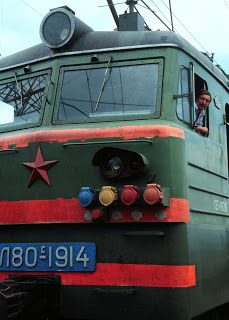 Trans-Siberian RailroadRain was coming down steadily, streaking the windshield and side windows. Occasionally I had to wipe the condensation from the interior of the glass so that I could watch the people coming and going. People watching in Russia, particularly Siberia, can be fascinating. We were parked near a covered stairway that led downward into the tunnels that went under the tracks and led to the various train platforms – and there were many. This is a major terminal for the Trans-Siberian Railroad. I had arrived here myself from Ulan Ude a few days earlier and nearly got lost getting from the train platform in the maze of tunnels. People were streaming in and out, most with umbrellas. It was then that I noticed the young couple standing huddled out of the rain in the opening of this portal. They had no umbrella and seemed to be waiting for a bus or a vehicle to pick them up. They were both in their late teens, perhaps early twenties - university students, I guessed. She was slight of build, very delicate and thin and I imagined that she might be a student of the ballet. He was taller, also slender, but I didn’t picture him as a ballet or dance student. A musician, perhaps. Or maybe a mathematics major. He held his arm around her shoulders and they looked at each other often, speaking a few words. Then they looked expectantly out into the expanse of the asphalt covered parking lot. There were few vehicles. In typical Soviet fashion, the parking lot was not a smooth surface of asphalt but was dimpled with numerous irregularities so that rainwater quickly formed puddles all around. I watched as some people picked their way across this minefield of puddled water. Obviously this parking lot had been designed by that most powerful of all Soviet bureaucracies, The Ministry of A and I (see next essay). Many minutes passed. I was fascinated with the couple before me. At one point he said something that made her laugh. She covered her mouth and lowered her eyes as she giggled. Then they both seriously surveyed the parking lot again. I wondered if they had arrived by train and from where? Ulan Ude? Or Irkutsk? Maybe Moscow, some five or six days distant by train from here? Or maybe from one of the many small towns and villages along the Trans-Siberian. But it struck me that they didn’t seem to be from one of those little Siberian villages. Their clothing was more urban. Maybe Vladivostok in the other direction. Or maybe they were from Khabarovsk and were just seeing a friend off and got caught in this rain. The fact that they didn’t appear to have any luggage seemed to confirm my last theory. Mesmerized in my voyeurism I suddenly became aware of a large vehicle approaching from behind. It slowed as it came past the car, but then continued on across the watery parking lot sending spray into the air as it hit each puddle. It was one of those Soviet era buses, rather grimy and painted a dull yellow color. It came to a stop at the far end of the parking lot – about one hundred yards away. I turned and now saw the couple moving quickly. She slipped off her shoes and he reached down and clutched them to his chest. They paused, as though to map a route across the watery course. Then he nodded and they began to run in the direction of the far bus. She ran with delicate, mincing steps almost on tiptoe. It was like watching a ballet. And apparently she preferred to run barefoot rather than to spoil what looked like new shoes. I wondered if they had assessed the risk of stepping on one of those broken vodka bottles so prevalent all over Russia. They ran hand in hand, dodging, when they could, the puddles. It took a few moments for them to traverse the space to the parked bus. But as they neared the vehicle it suddenly started moving, picking up speed as they drew closer. And when they arrived at the spot where the bus had been it was well out of the parking lot and onto the boulevard heading toward the city center. The young man waved, but it passed unnoticed by the driver – if he ever cared. The couple stood in the rain, shoulders slumped in defeat. He reached and embraced her. They stood a moment, then slowly started walking back in my direction to the portal where they had stood for so long waiting. The rain had eased to a slight drizzle, but it was obvious that they were both soaking wet. As I watched them huddle in the portal once more, looking anxiously for another bus, I felt profoundly sad. Though young, they were old enough to have lived most of their lives in the old Soviet system. The year was 1992 and though the Soviet Union was no more, the new Russia was only a year old and little had changed in the old infrastructure. What had saddened me most about the plight of this young couple was their stoicism and resignation to their fate. I was reminded of a slogan related to me by an older Russian friend, a saying that everyone used, sardonically, about life during Soviet times: “Nothing works, everything breaks, nobody cares.” Everyone, he said, resigned themselves to a miserable life of one frustration after another. If you didn’t accept the way things were you would either drink yourself to death or end up in prison. Many Soviet citizens did both.
Trans-Siberian RailroadRain was coming down steadily, streaking the windshield and side windows. Occasionally I had to wipe the condensation from the interior of the glass so that I could watch the people coming and going. People watching in Russia, particularly Siberia, can be fascinating. We were parked near a covered stairway that led downward into the tunnels that went under the tracks and led to the various train platforms – and there were many. This is a major terminal for the Trans-Siberian Railroad. I had arrived here myself from Ulan Ude a few days earlier and nearly got lost getting from the train platform in the maze of tunnels. People were streaming in and out, most with umbrellas. It was then that I noticed the young couple standing huddled out of the rain in the opening of this portal. They had no umbrella and seemed to be waiting for a bus or a vehicle to pick them up. They were both in their late teens, perhaps early twenties - university students, I guessed. She was slight of build, very delicate and thin and I imagined that she might be a student of the ballet. He was taller, also slender, but I didn’t picture him as a ballet or dance student. A musician, perhaps. Or maybe a mathematics major. He held his arm around her shoulders and they looked at each other often, speaking a few words. Then they looked expectantly out into the expanse of the asphalt covered parking lot. There were few vehicles. In typical Soviet fashion, the parking lot was not a smooth surface of asphalt but was dimpled with numerous irregularities so that rainwater quickly formed puddles all around. I watched as some people picked their way across this minefield of puddled water. Obviously this parking lot had been designed by that most powerful of all Soviet bureaucracies, The Ministry of A and I (see next essay). Many minutes passed. I was fascinated with the couple before me. At one point he said something that made her laugh. She covered her mouth and lowered her eyes as she giggled. Then they both seriously surveyed the parking lot again. I wondered if they had arrived by train and from where? Ulan Ude? Or Irkutsk? Maybe Moscow, some five or six days distant by train from here? Or maybe from one of the many small towns and villages along the Trans-Siberian. But it struck me that they didn’t seem to be from one of those little Siberian villages. Their clothing was more urban. Maybe Vladivostok in the other direction. Or maybe they were from Khabarovsk and were just seeing a friend off and got caught in this rain. The fact that they didn’t appear to have any luggage seemed to confirm my last theory. Mesmerized in my voyeurism I suddenly became aware of a large vehicle approaching from behind. It slowed as it came past the car, but then continued on across the watery parking lot sending spray into the air as it hit each puddle. It was one of those Soviet era buses, rather grimy and painted a dull yellow color. It came to a stop at the far end of the parking lot – about one hundred yards away. I turned and now saw the couple moving quickly. She slipped off her shoes and he reached down and clutched them to his chest. They paused, as though to map a route across the watery course. Then he nodded and they began to run in the direction of the far bus. She ran with delicate, mincing steps almost on tiptoe. It was like watching a ballet. And apparently she preferred to run barefoot rather than to spoil what looked like new shoes. I wondered if they had assessed the risk of stepping on one of those broken vodka bottles so prevalent all over Russia. They ran hand in hand, dodging, when they could, the puddles. It took a few moments for them to traverse the space to the parked bus. But as they neared the vehicle it suddenly started moving, picking up speed as they drew closer. And when they arrived at the spot where the bus had been it was well out of the parking lot and onto the boulevard heading toward the city center. The young man waved, but it passed unnoticed by the driver – if he ever cared. The couple stood in the rain, shoulders slumped in defeat. He reached and embraced her. They stood a moment, then slowly started walking back in my direction to the portal where they had stood for so long waiting. The rain had eased to a slight drizzle, but it was obvious that they were both soaking wet. As I watched them huddle in the portal once more, looking anxiously for another bus, I felt profoundly sad. Though young, they were old enough to have lived most of their lives in the old Soviet system. The year was 1992 and though the Soviet Union was no more, the new Russia was only a year old and little had changed in the old infrastructure. What had saddened me most about the plight of this young couple was their stoicism and resignation to their fate. I was reminded of a slogan related to me by an older Russian friend, a saying that everyone used, sardonically, about life during Soviet times: “Nothing works, everything breaks, nobody cares.” Everyone, he said, resigned themselves to a miserable life of one frustration after another. If you didn’t accept the way things were you would either drink yourself to death or end up in prison. Many Soviet citizens did both.
Published on December 13, 2012 07:45
December 12, 2012
Ulan Ude and an Eastern Medicine Clinic
This is the first in a series of essays entitled Travels in Siberia. These are various journeys I made here, starting in 1986. © Boyd Norton
Ulan Ude and an Eastern Medicine Clinic The journey on the Trans-Siberian Railroad between Khabarovsk and Ulan Ude is a trip backward in time. It takes two days, more or less, to travel between those two cities. For me it has the feeling of journeying back decades to the 1940s and 1950s of my childhood in Pawtucket, Rhode Island. I’m not suggesting that Rhode Island has the climate of Siberia. Nor does it, today, resemble this part of Siberia at all. However, during and immediately after World War II there was a certain look and feeling to my childhood surroundings that are nearly replicated today in many Siberian towns and cities. I still remember in Pawtucket those abandoned textile mills with broken windows, woodlots, grassy meadows, dirt streets (the street I lived on was not paved until the early ‘50s), weedy vacant lots, old but charming houses in need of painting, rundown wooden fences, and victory gardens in everyone’s backyard. Horse drawn wagons were not at all unusual then. Once a week the Ragman used to drive his horse and wagon down our street yelling in a sing-song voice, “Raaaaags.” He bought old clothing from people. I never understood how anyone could make a living doing that. There were others that delivered ice for iceboxes, also with horse and wagon. We got our ice from a nearby icehouse, probably because it was cheaper. Refrigerator? What’s that?The factories around Pawtucket that remained open were two or three story buildings made of brick darkened by age and pollution and with windows consisting of rectangular mosaics of many small panes whose glass was forever dirty and grimy and, occasionally, broken. Not at all unlike the Soviet era buildings found in Siberia. There were no shopping malls. There were no Safeways or Wal-Marts. Most people walked two or three blocks or more to small neighborhood groceries. Sidewalks, what few there were, had shaggy weeds growing up through the cracks. There were streetcars and electric buses that had spring loaded poles on the back to ride along the electrical wires overhead. There were trolleys that ran on rails imbedded in many of the main thoroughfares. Traffic jams were unheard of because very few people owned a car. Those that did kept and maintained them for many years. A brand new car was cause for gaping. It was a simple time. And not unpleasant, though for adults I’m sure it was a worrisome period after a major economic depression and a world war. Today American towns have become too slick and neat. No weed is allowed to spring up in a vacant lot. In fact, there are no vacant lots – they’ve long since been developed and turned into condos. (In my Pawtucket of old, certain parts of the city had many streets lined with tenements. Condos today are just a modern day equivalent of tenements.) No sidewalks today have cracks for weeds to sprout up through. No street remains unpaved and no lawn remains uncut. There are no more vegetable gardens in the backyard. The trolley cars have been replaced by multitudes of shiny new cars jammed bumper to bumper on streets lined with sterile shopping malls. No one walks. There are no horse drawn wagons.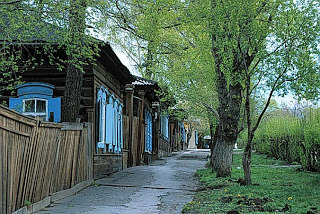 Street in IrkutskExcept in Siberia. There’s a nostalgic simplicity here. I think it’s part of the reason that I’m drawn to this strange and wonderful land. In Khabarovsk and Ulan Ude and Irkutsk there are still trolleys running on rails set in the streets. There are electric buses with poles reaching up to draw power from overhead wires. There are weedy lots and sidewalks with grass poking up through cracks. Old buildings in these cities are reminiscent of those rundown textile mills of Pawtucket. (Like the designers of those American mills, Soviet architects had no sense of aesthetics.)
Street in IrkutskExcept in Siberia. There’s a nostalgic simplicity here. I think it’s part of the reason that I’m drawn to this strange and wonderful land. In Khabarovsk and Ulan Ude and Irkutsk there are still trolleys running on rails set in the streets. There are electric buses with poles reaching up to draw power from overhead wires. There are weedy lots and sidewalks with grass poking up through cracks. Old buildings in these cities are reminiscent of those rundown textile mills of Pawtucket. (Like the designers of those American mills, Soviet architects had no sense of aesthetics.)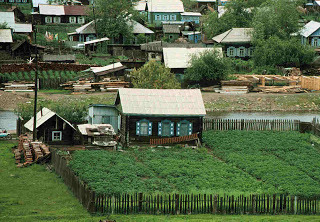 Gardens in Villages from the Trans-SiberianIn the countryside life is even simpler. Standing in the narrow hallway of the compartment car of the Trans-Siberian train, I stare out the open window for hours as we pass through lovely countryside. The train slows for small villages and towns. There I see old log homes and yards filled with lovingly tended gardens of potato plants and tomatoes and cabbages and carrots and beets. These are like our Victory Gardens of World War II years. For most people here those vegetables are vital for survival in long and bitter winters. There are rundown fences, houses in need of paint, dirt streets, and weedy lots. And yes, horse drawn wagons and carts. I feel at home here.
Gardens in Villages from the Trans-SiberianIn the countryside life is even simpler. Standing in the narrow hallway of the compartment car of the Trans-Siberian train, I stare out the open window for hours as we pass through lovely countryside. The train slows for small villages and towns. There I see old log homes and yards filled with lovingly tended gardens of potato plants and tomatoes and cabbages and carrots and beets. These are like our Victory Gardens of World War II years. For most people here those vegetables are vital for survival in long and bitter winters. There are rundown fences, houses in need of paint, dirt streets, and weedy lots. And yes, horse drawn wagons and carts. I feel at home here.
Ulan Ude is a city of 380,000 people lying more than 5000 kilometers (and five time zones) east of Moscow on the Trans-Siberian Railroad. It was founded as a Cossack outpost in 1666. The city sits astride the Selenga River whose origins are in Mongolia 200 kilometers to the south. The Selenga empties into Baikal about 100 kilometers west of the city.Were they to return today, I’m afraid the Cossacks would be in for a bit of a shock. Strategically located on the Trans-Siberian Railroad, Ulan Ude was transformed into one of those ugly Soviet industrial cities that sprang up in the Stalin era, from the 1930s through the 50s. With its belching factories and rows of sterile high rise apartments, the city could serve as poster child for the Ministry of Really Ugly Architecture in Moscow. Many of my trips to Lake Baikal have been through Ulan Ude because it gives easy access to some fascinating parts of the lake along the east shore. On some of those excursions I’ve stayed at an Eastern medicine clinic in Ulan Ude. It’s kind of a combination hospital and hostel, run by a wonderful Buryat gentleman named Baer Balzhirov. The clinic is located in a forest, typical Siberian taiga, on the eastern outskirts of the city. It’s a place to relax, away from the noise and traffic of Ulan Ude.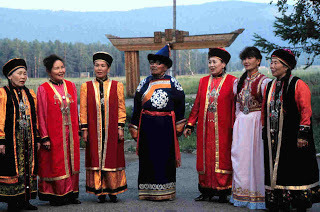 Buryat Singers at Eastern Medicine Clinic On one of my first visits Baer made arrangements for some of us to have a medical diagnosis made by one of the Eastern medicine practioners. I must admit that I’m something of a skeptic about certain alternative forms of medicine and some modern day folk remedies. Perhaps it’s my scientific background, but when I read wild claims made for certain herbs and treatments I’m suspicious. Good scientific testing of the effectiveness of these medicines seems to be lacking. I’m equally suspicious of various alternative medical treatments.On the other hand, I realize that in the natural world there are still some amazing substances awaiting discovery, complex derivatives from flora and fauna that may yield cures for many human maladies. On my many trips to Peru I discovered that the tea made from coca leaves actually does help acclimatization to high altitudes. So when Baer asked me, I agreed. What the hell, I thought. I’m game to give it a try and see if he diagnoses something interesting. The practitioner looked the part of a Buddhist monk, with shaven head and maroon robe. Rather than sandals he wore an ordinary pair of street shoes. The wingtips seemed to clash with the rest of his outfit, but I suppose this footware made more sense in the climate of Ulan Ude. His dark eyes had a piercing quality, giving the impression he could use his vision to penetrate skin and bone to root out sickness. He was introduced and we shook hands. He bowed slightly and I awkwardly bowed to him. With a sweep of his hand he asked me to be seated. I sat in a straight-backed chair and he seated himself opposite me on a sofa. I had been briefed on the procedure. The practitioner had been trained over many years to detect slight variations in the human pulse on each wrist and at different specific positions. According to the Eastern medicine theory there are something like twenty eight different pulse variations that can be detected by skilled practitioners. By understanding the meaning of changes in these pulses one can make diagnoses of certain illnesses or afflictions. I tried not to let my skepticism show. He leaned forward, grasped my forearms and rotated them so that my palms were facing upward. He placed his fingertips on my wrists in much the same way a doctor or nurse might when checking a pulse. However, rather than a fixed position, he moved his fingers to different spots and applied varying pressure. Also, he used both hands, one on each of my wrists. Sometimes his fingertips barely touched my skin, giving a tickling sensation. At other times the pressure was firm and hard. He spent several minutes doing this, moving his fingers from place to place on my wrists and forearms. All the time there was a look of intense concentration on his face and he cocked his head in such a way that it appeared he was listening for something as well. Suddenly he looked up at me and asked if I had any particular medical problems. The question took me by surprise – Hey, I thought, he was supposed to root out my problems on his own. I mulled over his question for a moment. I’m in pretty good health and, aside from an occasional cold or bout of the flu, I’ve had almost no medical – Oh, wait a minute. Yes, I explained to him, I do have one problem. You see, I went on, I’m a photographer and often I carry a lot of camera equipment, up to 15 kilos (over 30 pounds) - sometimes more. On days when I do a lot of walking while carrying that camera gear, well, at the end of the day my hip joints ache. Sometimes I cannot sleep well at night because of that pain. He nodded in understanding and once more grasped my wrists. Again he used his fingertips to probe my pulses. His brow was furrowed in concentration. Then he looked up at me about to speak. I must admit I got excited. Even though I was skeptical about this procedure, I recalled articles I had read about various new medicines derived from old, traditional herbs and remedies from ancient cultures worldwide. Maybe there is something to this. Siberia is noted for its ginseng and other herbal medicines. Surely he is about to prescribe some ointment or salve or tea made from the extract of leaves or bark or roots of a hitherto unknown but magical Siberian plant. And this would cure my aching joints. He cleared his throat and then spoke. “You’re getting old,” he said. He didn’t even crack a smile.
Buryat Singers at Eastern Medicine Clinic On one of my first visits Baer made arrangements for some of us to have a medical diagnosis made by one of the Eastern medicine practioners. I must admit that I’m something of a skeptic about certain alternative forms of medicine and some modern day folk remedies. Perhaps it’s my scientific background, but when I read wild claims made for certain herbs and treatments I’m suspicious. Good scientific testing of the effectiveness of these medicines seems to be lacking. I’m equally suspicious of various alternative medical treatments.On the other hand, I realize that in the natural world there are still some amazing substances awaiting discovery, complex derivatives from flora and fauna that may yield cures for many human maladies. On my many trips to Peru I discovered that the tea made from coca leaves actually does help acclimatization to high altitudes. So when Baer asked me, I agreed. What the hell, I thought. I’m game to give it a try and see if he diagnoses something interesting. The practitioner looked the part of a Buddhist monk, with shaven head and maroon robe. Rather than sandals he wore an ordinary pair of street shoes. The wingtips seemed to clash with the rest of his outfit, but I suppose this footware made more sense in the climate of Ulan Ude. His dark eyes had a piercing quality, giving the impression he could use his vision to penetrate skin and bone to root out sickness. He was introduced and we shook hands. He bowed slightly and I awkwardly bowed to him. With a sweep of his hand he asked me to be seated. I sat in a straight-backed chair and he seated himself opposite me on a sofa. I had been briefed on the procedure. The practitioner had been trained over many years to detect slight variations in the human pulse on each wrist and at different specific positions. According to the Eastern medicine theory there are something like twenty eight different pulse variations that can be detected by skilled practitioners. By understanding the meaning of changes in these pulses one can make diagnoses of certain illnesses or afflictions. I tried not to let my skepticism show. He leaned forward, grasped my forearms and rotated them so that my palms were facing upward. He placed his fingertips on my wrists in much the same way a doctor or nurse might when checking a pulse. However, rather than a fixed position, he moved his fingers to different spots and applied varying pressure. Also, he used both hands, one on each of my wrists. Sometimes his fingertips barely touched my skin, giving a tickling sensation. At other times the pressure was firm and hard. He spent several minutes doing this, moving his fingers from place to place on my wrists and forearms. All the time there was a look of intense concentration on his face and he cocked his head in such a way that it appeared he was listening for something as well. Suddenly he looked up at me and asked if I had any particular medical problems. The question took me by surprise – Hey, I thought, he was supposed to root out my problems on his own. I mulled over his question for a moment. I’m in pretty good health and, aside from an occasional cold or bout of the flu, I’ve had almost no medical – Oh, wait a minute. Yes, I explained to him, I do have one problem. You see, I went on, I’m a photographer and often I carry a lot of camera equipment, up to 15 kilos (over 30 pounds) - sometimes more. On days when I do a lot of walking while carrying that camera gear, well, at the end of the day my hip joints ache. Sometimes I cannot sleep well at night because of that pain. He nodded in understanding and once more grasped my wrists. Again he used his fingertips to probe my pulses. His brow was furrowed in concentration. Then he looked up at me about to speak. I must admit I got excited. Even though I was skeptical about this procedure, I recalled articles I had read about various new medicines derived from old, traditional herbs and remedies from ancient cultures worldwide. Maybe there is something to this. Siberia is noted for its ginseng and other herbal medicines. Surely he is about to prescribe some ointment or salve or tea made from the extract of leaves or bark or roots of a hitherto unknown but magical Siberian plant. And this would cure my aching joints. He cleared his throat and then spoke. “You’re getting old,” he said. He didn’t even crack a smile.

Ulan Ude and an Eastern Medicine Clinic The journey on the Trans-Siberian Railroad between Khabarovsk and Ulan Ude is a trip backward in time. It takes two days, more or less, to travel between those two cities. For me it has the feeling of journeying back decades to the 1940s and 1950s of my childhood in Pawtucket, Rhode Island. I’m not suggesting that Rhode Island has the climate of Siberia. Nor does it, today, resemble this part of Siberia at all. However, during and immediately after World War II there was a certain look and feeling to my childhood surroundings that are nearly replicated today in many Siberian towns and cities. I still remember in Pawtucket those abandoned textile mills with broken windows, woodlots, grassy meadows, dirt streets (the street I lived on was not paved until the early ‘50s), weedy vacant lots, old but charming houses in need of painting, rundown wooden fences, and victory gardens in everyone’s backyard. Horse drawn wagons were not at all unusual then. Once a week the Ragman used to drive his horse and wagon down our street yelling in a sing-song voice, “Raaaaags.” He bought old clothing from people. I never understood how anyone could make a living doing that. There were others that delivered ice for iceboxes, also with horse and wagon. We got our ice from a nearby icehouse, probably because it was cheaper. Refrigerator? What’s that?The factories around Pawtucket that remained open were two or three story buildings made of brick darkened by age and pollution and with windows consisting of rectangular mosaics of many small panes whose glass was forever dirty and grimy and, occasionally, broken. Not at all unlike the Soviet era buildings found in Siberia. There were no shopping malls. There were no Safeways or Wal-Marts. Most people walked two or three blocks or more to small neighborhood groceries. Sidewalks, what few there were, had shaggy weeds growing up through the cracks. There were streetcars and electric buses that had spring loaded poles on the back to ride along the electrical wires overhead. There were trolleys that ran on rails imbedded in many of the main thoroughfares. Traffic jams were unheard of because very few people owned a car. Those that did kept and maintained them for many years. A brand new car was cause for gaping. It was a simple time. And not unpleasant, though for adults I’m sure it was a worrisome period after a major economic depression and a world war. Today American towns have become too slick and neat. No weed is allowed to spring up in a vacant lot. In fact, there are no vacant lots – they’ve long since been developed and turned into condos. (In my Pawtucket of old, certain parts of the city had many streets lined with tenements. Condos today are just a modern day equivalent of tenements.) No sidewalks today have cracks for weeds to sprout up through. No street remains unpaved and no lawn remains uncut. There are no more vegetable gardens in the backyard. The trolley cars have been replaced by multitudes of shiny new cars jammed bumper to bumper on streets lined with sterile shopping malls. No one walks. There are no horse drawn wagons.
 Street in IrkutskExcept in Siberia. There’s a nostalgic simplicity here. I think it’s part of the reason that I’m drawn to this strange and wonderful land. In Khabarovsk and Ulan Ude and Irkutsk there are still trolleys running on rails set in the streets. There are electric buses with poles reaching up to draw power from overhead wires. There are weedy lots and sidewalks with grass poking up through cracks. Old buildings in these cities are reminiscent of those rundown textile mills of Pawtucket. (Like the designers of those American mills, Soviet architects had no sense of aesthetics.)
Street in IrkutskExcept in Siberia. There’s a nostalgic simplicity here. I think it’s part of the reason that I’m drawn to this strange and wonderful land. In Khabarovsk and Ulan Ude and Irkutsk there are still trolleys running on rails set in the streets. There are electric buses with poles reaching up to draw power from overhead wires. There are weedy lots and sidewalks with grass poking up through cracks. Old buildings in these cities are reminiscent of those rundown textile mills of Pawtucket. (Like the designers of those American mills, Soviet architects had no sense of aesthetics.) Gardens in Villages from the Trans-SiberianIn the countryside life is even simpler. Standing in the narrow hallway of the compartment car of the Trans-Siberian train, I stare out the open window for hours as we pass through lovely countryside. The train slows for small villages and towns. There I see old log homes and yards filled with lovingly tended gardens of potato plants and tomatoes and cabbages and carrots and beets. These are like our Victory Gardens of World War II years. For most people here those vegetables are vital for survival in long and bitter winters. There are rundown fences, houses in need of paint, dirt streets, and weedy lots. And yes, horse drawn wagons and carts. I feel at home here.
Gardens in Villages from the Trans-SiberianIn the countryside life is even simpler. Standing in the narrow hallway of the compartment car of the Trans-Siberian train, I stare out the open window for hours as we pass through lovely countryside. The train slows for small villages and towns. There I see old log homes and yards filled with lovingly tended gardens of potato plants and tomatoes and cabbages and carrots and beets. These are like our Victory Gardens of World War II years. For most people here those vegetables are vital for survival in long and bitter winters. There are rundown fences, houses in need of paint, dirt streets, and weedy lots. And yes, horse drawn wagons and carts. I feel at home here.Ulan Ude is a city of 380,000 people lying more than 5000 kilometers (and five time zones) east of Moscow on the Trans-Siberian Railroad. It was founded as a Cossack outpost in 1666. The city sits astride the Selenga River whose origins are in Mongolia 200 kilometers to the south. The Selenga empties into Baikal about 100 kilometers west of the city.Were they to return today, I’m afraid the Cossacks would be in for a bit of a shock. Strategically located on the Trans-Siberian Railroad, Ulan Ude was transformed into one of those ugly Soviet industrial cities that sprang up in the Stalin era, from the 1930s through the 50s. With its belching factories and rows of sterile high rise apartments, the city could serve as poster child for the Ministry of Really Ugly Architecture in Moscow. Many of my trips to Lake Baikal have been through Ulan Ude because it gives easy access to some fascinating parts of the lake along the east shore. On some of those excursions I’ve stayed at an Eastern medicine clinic in Ulan Ude. It’s kind of a combination hospital and hostel, run by a wonderful Buryat gentleman named Baer Balzhirov. The clinic is located in a forest, typical Siberian taiga, on the eastern outskirts of the city. It’s a place to relax, away from the noise and traffic of Ulan Ude.
 Buryat Singers at Eastern Medicine Clinic On one of my first visits Baer made arrangements for some of us to have a medical diagnosis made by one of the Eastern medicine practioners. I must admit that I’m something of a skeptic about certain alternative forms of medicine and some modern day folk remedies. Perhaps it’s my scientific background, but when I read wild claims made for certain herbs and treatments I’m suspicious. Good scientific testing of the effectiveness of these medicines seems to be lacking. I’m equally suspicious of various alternative medical treatments.On the other hand, I realize that in the natural world there are still some amazing substances awaiting discovery, complex derivatives from flora and fauna that may yield cures for many human maladies. On my many trips to Peru I discovered that the tea made from coca leaves actually does help acclimatization to high altitudes. So when Baer asked me, I agreed. What the hell, I thought. I’m game to give it a try and see if he diagnoses something interesting. The practitioner looked the part of a Buddhist monk, with shaven head and maroon robe. Rather than sandals he wore an ordinary pair of street shoes. The wingtips seemed to clash with the rest of his outfit, but I suppose this footware made more sense in the climate of Ulan Ude. His dark eyes had a piercing quality, giving the impression he could use his vision to penetrate skin and bone to root out sickness. He was introduced and we shook hands. He bowed slightly and I awkwardly bowed to him. With a sweep of his hand he asked me to be seated. I sat in a straight-backed chair and he seated himself opposite me on a sofa. I had been briefed on the procedure. The practitioner had been trained over many years to detect slight variations in the human pulse on each wrist and at different specific positions. According to the Eastern medicine theory there are something like twenty eight different pulse variations that can be detected by skilled practitioners. By understanding the meaning of changes in these pulses one can make diagnoses of certain illnesses or afflictions. I tried not to let my skepticism show. He leaned forward, grasped my forearms and rotated them so that my palms were facing upward. He placed his fingertips on my wrists in much the same way a doctor or nurse might when checking a pulse. However, rather than a fixed position, he moved his fingers to different spots and applied varying pressure. Also, he used both hands, one on each of my wrists. Sometimes his fingertips barely touched my skin, giving a tickling sensation. At other times the pressure was firm and hard. He spent several minutes doing this, moving his fingers from place to place on my wrists and forearms. All the time there was a look of intense concentration on his face and he cocked his head in such a way that it appeared he was listening for something as well. Suddenly he looked up at me and asked if I had any particular medical problems. The question took me by surprise – Hey, I thought, he was supposed to root out my problems on his own. I mulled over his question for a moment. I’m in pretty good health and, aside from an occasional cold or bout of the flu, I’ve had almost no medical – Oh, wait a minute. Yes, I explained to him, I do have one problem. You see, I went on, I’m a photographer and often I carry a lot of camera equipment, up to 15 kilos (over 30 pounds) - sometimes more. On days when I do a lot of walking while carrying that camera gear, well, at the end of the day my hip joints ache. Sometimes I cannot sleep well at night because of that pain. He nodded in understanding and once more grasped my wrists. Again he used his fingertips to probe my pulses. His brow was furrowed in concentration. Then he looked up at me about to speak. I must admit I got excited. Even though I was skeptical about this procedure, I recalled articles I had read about various new medicines derived from old, traditional herbs and remedies from ancient cultures worldwide. Maybe there is something to this. Siberia is noted for its ginseng and other herbal medicines. Surely he is about to prescribe some ointment or salve or tea made from the extract of leaves or bark or roots of a hitherto unknown but magical Siberian plant. And this would cure my aching joints. He cleared his throat and then spoke. “You’re getting old,” he said. He didn’t even crack a smile.
Buryat Singers at Eastern Medicine Clinic On one of my first visits Baer made arrangements for some of us to have a medical diagnosis made by one of the Eastern medicine practioners. I must admit that I’m something of a skeptic about certain alternative forms of medicine and some modern day folk remedies. Perhaps it’s my scientific background, but when I read wild claims made for certain herbs and treatments I’m suspicious. Good scientific testing of the effectiveness of these medicines seems to be lacking. I’m equally suspicious of various alternative medical treatments.On the other hand, I realize that in the natural world there are still some amazing substances awaiting discovery, complex derivatives from flora and fauna that may yield cures for many human maladies. On my many trips to Peru I discovered that the tea made from coca leaves actually does help acclimatization to high altitudes. So when Baer asked me, I agreed. What the hell, I thought. I’m game to give it a try and see if he diagnoses something interesting. The practitioner looked the part of a Buddhist monk, with shaven head and maroon robe. Rather than sandals he wore an ordinary pair of street shoes. The wingtips seemed to clash with the rest of his outfit, but I suppose this footware made more sense in the climate of Ulan Ude. His dark eyes had a piercing quality, giving the impression he could use his vision to penetrate skin and bone to root out sickness. He was introduced and we shook hands. He bowed slightly and I awkwardly bowed to him. With a sweep of his hand he asked me to be seated. I sat in a straight-backed chair and he seated himself opposite me on a sofa. I had been briefed on the procedure. The practitioner had been trained over many years to detect slight variations in the human pulse on each wrist and at different specific positions. According to the Eastern medicine theory there are something like twenty eight different pulse variations that can be detected by skilled practitioners. By understanding the meaning of changes in these pulses one can make diagnoses of certain illnesses or afflictions. I tried not to let my skepticism show. He leaned forward, grasped my forearms and rotated them so that my palms were facing upward. He placed his fingertips on my wrists in much the same way a doctor or nurse might when checking a pulse. However, rather than a fixed position, he moved his fingers to different spots and applied varying pressure. Also, he used both hands, one on each of my wrists. Sometimes his fingertips barely touched my skin, giving a tickling sensation. At other times the pressure was firm and hard. He spent several minutes doing this, moving his fingers from place to place on my wrists and forearms. All the time there was a look of intense concentration on his face and he cocked his head in such a way that it appeared he was listening for something as well. Suddenly he looked up at me and asked if I had any particular medical problems. The question took me by surprise – Hey, I thought, he was supposed to root out my problems on his own. I mulled over his question for a moment. I’m in pretty good health and, aside from an occasional cold or bout of the flu, I’ve had almost no medical – Oh, wait a minute. Yes, I explained to him, I do have one problem. You see, I went on, I’m a photographer and often I carry a lot of camera equipment, up to 15 kilos (over 30 pounds) - sometimes more. On days when I do a lot of walking while carrying that camera gear, well, at the end of the day my hip joints ache. Sometimes I cannot sleep well at night because of that pain. He nodded in understanding and once more grasped my wrists. Again he used his fingertips to probe my pulses. His brow was furrowed in concentration. Then he looked up at me about to speak. I must admit I got excited. Even though I was skeptical about this procedure, I recalled articles I had read about various new medicines derived from old, traditional herbs and remedies from ancient cultures worldwide. Maybe there is something to this. Siberia is noted for its ginseng and other herbal medicines. Surely he is about to prescribe some ointment or salve or tea made from the extract of leaves or bark or roots of a hitherto unknown but magical Siberian plant. And this would cure my aching joints. He cleared his throat and then spoke. “You’re getting old,” he said. He didn’t even crack a smile.
Published on December 12, 2012 13:34
October 28, 2012
Wildlife Prints
Published on October 28, 2012 11:12
African Wildlife
Published on October 28, 2012 11:11
Africa Prints
Published on October 28, 2012 11:09
Serengeti Ecosystem Prints
Published on October 28, 2012 11:07


